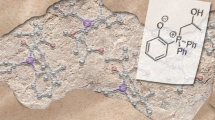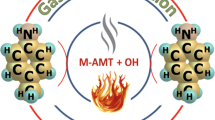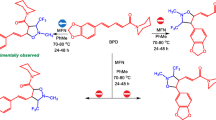Abstract
We present a theoretical analysis of the reaction mechanisms on Lithium Carbenoids LiCH2X (X = F, Cl y Br) and ketenes at B3LYP/6-311++G(d,p) level at the IRC. We have considered the implicit solvation effects of dichloromethane using the PCM methodology. For the reaction coordinate analysis, we have used the reaction force analysis and the theoretical tools coming from conceptual DFT, NBO populations and NCI. The reaction mechanism has a barrierless step corresponding to the interaction of the carbenoid and the hydrogen of the ketene α carbon and a single kinetic step representing the bonding of the carbon carbenoid to the ketene α carbon, the activation of the reaction proceeds mostly by electrostatic interactions perpendicular to the molecular plane followed by a rotation of the ketene showing the influence of the ionic nature of the carbenoid, and the following formation of the bond with the ketene β carbon atom. All three reactions are highly exothermic leading to a decomposition product that is far lower in energy than the cyclopropanone. The tendency of the reaction barriers is LiCH2Br < LiCH2Cl < LiCH2F, indicating that the bromine carbenoid is the most reactive molecule of this group.









Similar content being viewed by others
References
Bergstrom BD, Nickerson LA, Shaw JT, Souza LW (2021) Transition metal catalyzed insertion reactions with donor/donor carbenes. Angew Chem Int Ed 60:6864–6878. https://doi.org/10.1002/anie.202007001
Boche G, Lohrenz JCW (2001) The electrophilic nature of carbenoids, nitrenoids, and oxenoids. Chem Rev 101:697–756. https://doi.org/10.1021/cr940260x
Lopes R, Royo B (2017) Iron N-heterocyclic carbenes in reduction reactions. Isr J Chem 57:1151–1159. https://doi.org/10.1002/ijch.201700055
Nishimura RHV, Murie VE, Soldi RA, Lopes JLC, Clososki GC (2015) Zinc, lithium and magnesium carbenoids: chemical properties and relevant applications in organic synthesis. J Braz Chem Soc. https://doi.org/10.5935/0103-5053.20150218
Gessner VH (2016) Stability and reactivity control of carbenoids: recent advances and perspectives. Chem Commun 52:12011–12023. https://doi.org/10.1039/c6cc05524a
Ielo L, Castoldi L, Touqeer S, Lombino J, Roller A, Prandi C, Holzer W, Pace V (2020) Halogen-imparted reactivity in lithium carbenoid mediated homologations of imine surrogates: direct assembly of bis-trifluoromethyl-β-diketiminates and the dual role of LiCH2I. Angew Chem Int Ed 59:20852–20857. https://doi.org/10.1002/anie.202007954
Monticelli S, Rui M, Castoldi L, Missere G, Pace V (2018) A practical guide for using lithium halocarbenoids in homologation reactions. Monatshefte Für Chem Chem Mon 149:1285–1291. https://doi.org/10.1007/s00706-018-2232-9
Capriati V, Florio S (2010) Anatomy of long-lasting love affairs with lithium carbenoids: past and present status and future prospects. Chem Eur J 16:4152–4162. https://doi.org/10.1002/chem.200902870
Pace V (2014) Halomethyllithium carbenoids: versatile reagents for the homologation of electrophilic carbon units. Aust J Chem 67:311. https://doi.org/10.1071/CH13416
Thomas E, Kasatkin AN, Whitby RJ (2006) Cyclopropyl carbenoid insertion into alkenylzirconocenes—a convergent synthesis of alkenylcyclopropanes and alkylidenecyclopropanes. Tetrahedron Lett 47:9181–9185. https://doi.org/10.1016/j.tetlet.2006.10.132
Candeias NR, Paterna R, Gois PMP (2016) Homologation reaction of ketones with diazo compounds. Chem Rev 116:2937–2981. https://doi.org/10.1021/acs.chemrev.5b00381
Simmons HE, Smith RD (1958) A new synthesis of cyclopropanes from olefins. J Am Chem Soc 80:5323–5324. https://doi.org/10.1021/ja01552a080
Mamuye A (2014) Chloromethyllithium. Synlett 25:2814–2815. https://doi.org/10.1055/s-0034-1379442
Zhang XH, Zhang FL, Geng ZY (2010) A theoretical study of the carbenoids LiCH2X (X = Cl, Br, I) cyclopropanation reaction with ketene. J Chem Sci 122:363–369. https://doi.org/10.1007/s12039-010-0041-8
Turro NJ (1969) Cyclopropanones. Acc Chem Res 2:25–32. https://doi.org/10.1021/ar50013a004
Politzer P, Toro-Labbé A, Gutiérrez-Oliva S, Herrera B, Jaque P, Concha MC, Murray JS (2005) The reaction force: three key points along an intrinsic reaction coordinate. J Chem Sci 117:467–472. https://doi.org/10.1007/BF02708350
Toro-Labbé A, Gutiérrez-Oliva S, Murray JS, Politzer P (2009) The reaction force and the transition region of a reaction. J Mol Model 15:707–710. https://doi.org/10.1007/s00894-008-0431-8
Proft FD, Liu S, Parr RG (1997) Chemical potential, hardness, hardness and softness kernel and local hardness in the isomorphic ensemble of density functional theory. J Chem Phys 107:3000–3006. https://doi.org/10.1063/1.474657
Parr RG, Yang W (1989) Density functional theory of atoms and molecules, 1st edn. Oxford University Press, Oxford
Geerlings P, Proft FD, Langenaeker W (2003) Conceptual density functional theory. Chem Rev 103:1793–1874. https://doi.org/10.1021/cr990029p
Foster JP, Weinhold F (1980) Natural hybrid orbitals. J Am Chem Soc 102:7211–7218. https://doi.org/10.1021/ja00544a007
Reed AE, Weinhold F (1985) Natural localized molecular orbitals. J Chem Phys 83:1736–1740. https://doi.org/10.1063/1.449360
Contreras-García J, Johnson ER, Keinan S, Chaudret R, Piquemal J-P, Beratan DN, Yang W (2011) NCIPLOT: a program for plotting non-covalent interaction regions. J Chem Theory Comput 7:625–632. https://doi.org/10.1021/ct100641a
Contreras-García J, Boto RA, Izquierdo-Ruiz F, Reva I, Woller T, Alonso M (2016) A benchmark for the non-covalent interaction (NCI) index or… is it really all in the geometry? Theor Chem Acc 135:242–242. https://doi.org/10.1007/s00214-016-1977-7
Herrera B, Toro-Labbé A (2004) The role of the reaction force to characterize local specific interactions that activate the intramolecular proton transfers in DNA basis. J Chem Phys 121:7096. https://doi.org/10.1063/1.1792091
Herrera B, Toro-Labbé A (2007) The role of reaction force and chemical potential in characterizing the mechanism of double proton transfer in the adenine−uracil complex. J Phys Chem A 111:5921–5926. https://doi.org/10.1021/jp065951z
Geerlings P, Chamorro E, Chattaraj PK, Proft FD, Gázquez JL, Liu S, Morell C, Toro-Labbé A, Vela A, Ayers P (2020) Conceptual density functional theory: status, prospects, issues. Theor Chem Acc 139:36–36. https://doi.org/10.1007/s00214-020-2546-7
Cerón ML, Echegaray E, Gutiérrez-Oliva S, Herrera B, Toro-Labbé A (2011) The reaction electronic flux in chemical reactions. Sci China Chem 54:1982–1988. https://doi.org/10.1007/s11426-011-4447-z
Morell C, Tognetti V, Bignon E, Dumont E, Hernandez-Haro N, Herrera B, Grand A, Gutiérrez-Oliva S, Joubert L, Toro-Labbé A, Chermette H (2015) Insights into the chemical meanings of the reaction electronic flux. Theor Chem Acc 134:133. https://doi.org/10.1007/s00214-015-1730-7
Vela A, Gazquez JL (1990) A relationship between the static dipole polarizability, the global softness, and the Fukui function. J Am Chem Soc 112:1490–1492. https://doi.org/10.1021/ja00160a029
Tiznado W, Chamorro E, Contreras R, Fuentealba P (2005) Comparison among four different ways to condense the Fukui function. J Phys Chem A 109:3220–3224. https://doi.org/10.1021/jp0450787
Bulat FA, Chamorro E, Fuentealba P, Toro-Labbé A (2004) Condensation of frontier molecular orbital Fukui functions. J Phys Chem A 108:342–349. https://doi.org/10.1021/jp036416r
Yang W, Parr RG, Pucci R (1984) Electron density, Kohn-Sham frontier orbitals, and Fukui functions. J Chem Phys 81:2862–2863. https://doi.org/10.1063/1.447964
Morell C, Grand A, Toro-Labbé A (2005) New dual descriptor for chemical reactivity. J Phys Chem A 109:205–212. https://doi.org/10.1021/jp046577a
Morell C, Ayers PW, Grand A, Gutiérrez-Oliva S, Toro-Labbé A (2008) Rationalization of Diels-Alder reactions through the use of the dual reactivity descriptor Deltaf(r). Phys Chem Chem Phys PCCP 10:7239–7246. https://doi.org/10.1039/b810343g
Morell C, Grand A, Toro-Labbé A (2006) Theoretical support for using the Delta f(r) descriptor. Chem Phys Lett 425:342–346. https://doi.org/10.1016/j.cplett.2006.05.003
Becke AD (1993) A new mixing of Hartree-Fock and local density-functional theories. J Chem Phys 98:1372–1377. https://doi.org/10.1063/1.464304
Fukui K (1981) The path of chemical reactions—the IRC approach. Acc Chem Res 14:363–368. https://doi.org/10.1021/ar00072a001
McQuarrie DA, Simon JD (1999) Molecular thermodynamics. University Science Books, Sausalito
Improta R, Barone V, Scalmani G, Frisch MJ (2006) A state-specific polarizable continuum model time dependent density functional theory method for excited state calculations in solution. J Chem Phys 125:054103. https://doi.org/10.1063/1.2222364
Frisch MJ, Trucks GW, Schlegel HB, Scuseria GE, Robb MA, Cheeseman JR, Scalmani G, Barone V, Petersson GA, Nakatsuji H, Li X, Caricato M, Marenich AV, Bloino J, Janesko BG, Gomperts R, Mennucci B, Hratchian HP, Ortiz JV, Izmaylov AF, Sonnenberg JL, Williams-Young D, Ding F, Lipparini F, Egidi F, Goings J, Peng B, Petrone A, Henderson T, Ranasinghe D, Zakrzewski VG, Gao J, Rega N, Zheng G, Liang W, Hada M, Ehara M, Toyota K, Fukuda R, Hasegawa J, Ishida M, Nakajima T, Honda Y, Kitao O, Nakai H, Vreven T, Throssell K, Montgomery JA, Jr., Peralta JE, Ogliaro F, Bearpark MJ, Heyd JJ, Brothers EN, Kudin KN, Staroverov VN, Keith TA, Kobayashi R, Normand J, Raghavachari K, Rendell AP, Burant JC, Iyengar SS, Tomasi J, Cossi M, Millam JM, Klene M, Adamo C, Cammi R, Ochterski JW, Martin RL, Morokuma K, Farkas O, Foresman JB, Fox DJ (2016) Gaussian 16
Dennington II RD, Keith TA, Millam JM. GaussView 6.0.16
Lu T, Chen F (2011) Multiwfn: a multifunctional wavefunction analyzer. J Comput Chem 33:580–592. https://doi.org/10.1002/jcc.22885
Williams T, Kelly C et al (2013) Gnuplot 4.6: an interactive plotting program
Humphrey W, Dalke A, Schulten K (1996) VMD: Visual molecular dynamics. J Mol Graph 14:33–38. https://doi.org/10.1016/0263-7855(96)00018-5
Houk KN, Strozier RW, Hall JA (1974) Heterocumulene molecular orbitals: Ketenes, isocyanates, sulfenes, and sulfonylanines. Tetrahedron Lett 15:897–900. https://doi.org/10.1016/S0040-4039(01)82363-7
Acknowledgements
FONDECYT 1170837 awarded by BH.
Author information
Authors and Affiliations
Contributions
Daniel Villablanca did most of the calculations of the PES and figures. Sasha Gazzari did calculations of the electronic properties, dual descriptor and molecular orbitals. Barbara Herrera wrote and proofread the manuscript.
Corresponding author
Ethics declarations
Conflict of interest
The authors declare no competing interests.
Additional information
Publisher's Note
Springer Nature remains neutral with regard to jurisdictional claims in published maps and institutional affiliations.
Supplementary Information
Below is the link to the electronic supplementary material.
Rights and permissions
Springer Nature or its licensor (e.g. a society or other partner) holds exclusive rights to this article under a publishing agreement with the author(s) or other rightsholder(s); author self-archiving of the accepted manuscript version of this article is solely governed by the terms of such publishing agreement and applicable law.
About this article
Cite this article
Villablanca, D., Gazzari, S. & Herrera, B. The study of the PES and the reaction mechanism between ketene and Lithium Carbenoids and the formation of cyclopropanone. Theor Chem Acc 142, 32 (2023). https://doi.org/10.1007/s00214-023-02965-2
Received:
Accepted:
Published:
DOI: https://doi.org/10.1007/s00214-023-02965-2




